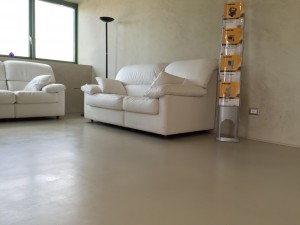General characteristics and historic development of resins for flooring
 What is it?
What is it?
You have heard about resins for flooring and you have faced the question: what are they? We know the existence of resins in nature (like those we can see on some varieties of trees or because we like amber jewelry, these are natural resins), now it comes to floors and walls? Well yes; we are talking about water-based substances, with no solvents, composed of polymers obtained in different ways. They are viscous materials, that look like the most common natural resins and are used in the field of construction and in flooring renovations, counter tops, such as kitchen tops, for coatings such as walls, pillars etc… and sometimes even for furnishings.
you have faced the question: what are they? We know the existence of resins in nature (like those we can see on some varieties of trees or because we like amber jewelry, these are natural resins), now it comes to floors and walls? Well yes; we are talking about water-based substances, with no solvents, composed of polymers obtained in different ways. They are viscous materials, that look like the most common natural resins and are used in the field of construction and in flooring renovations, counter tops, such as kitchen tops, for coatings such as walls, pillars etc… and sometimes even for furnishings.
Resins for flooring are therefore synthetic, they are substances that, depending on constitution and composition, have a huge variety of different characteristics, as well as specific uses. Even weight can vary significantly between different types of resins, the same for consistency, elasticity and viscosity. This way they can be used for different purposes.
Their spread nowadays is so wide that now it seems almost impossible to image a world without resins or plastics. We are not taking into consideration only the varieties for floorings, but all those materials that has become part of our daily life, now of common use.
Let’s think about the materials that can be used for phones, suitcases, computers, the bumper of our car. Or even a kitchen top, a table and the chairs, water bottles, the structure of many appliances, a sofa in pleather and so on. We can give examples indefinitely, till arriving to that part of buildings where we take our steps and on we arrange furniture and decorative objects: the flooring. If we have to create a new one or just renovate, we can take into consideration a new and beautiful resin flooring.
It’s incredible how synthetic resin, almost without us knowing about it, has become part of our lives. Now the applications of this material are so widespread and deeply rooted in our everyday life, even if we don’t think about it. The first experiments on (synthetic) resins, polymers and plastics, were carried out by the middle of the nineteenth century, but they were mostly pioneering studies.
It took many decades before arriving at the creation of the firt real artificial resin, in the early nineteenth century, by a Belgian chemist in New York. A year later his product was mixed with fossil resin to get the famous Bakelite, the first synthetic resin.
early nineteenth century, by a Belgian chemist in New York. A year later his product was mixed with fossil resin to get the famous Bakelite, the first synthetic resin.
Since then there was a constant race to the creation and discovery of new resins, even if the floorings ones were still far away. Synthetic materials were created, from polyester fibers to polyurethanes, to ureic and acrylic and so on. The mass marketing of those compounds occurred not before the fifties, but the boom was in the sixties and seventies.
Synthetic materials
In the following decades the production systems were improved and developed, thanks to new machineries, equipment and knowledge. The next step was a continuous increased commercial interest related to resins. These factors have resulted in projecting new and better tyes of resins.
Resins for flooring are only a small part of the world of synthetic materials, which are divided into 2 major groups, the one of thermoplastic resins and the one of thermosetting resins. The first are those that can be heated, fused and reformed several times, always keeping the possibility of processing.
The latter instead can be processed only once. They can be handled during the cooling phase, but once it is completed they are already in the process of cross-linking, that is the formation of a stable structure, that will remain from then on. They will never be recast, because with a new heating the substance simply got rotten.
There are also elastomers, which always mantain constant their characteristics of extensibility and elasticity. Polymers on the market – and in particular resins – are made of different components and so it is fundamental the knowledge and perfect preparation, both technical and theoretical, of the producer. Only the one who perfectly know the basic substances can create a great product.
It is fundamental the knowledge of the characteristics of the components that constitute the specific type of resin. It is necessary to know exactly how to mix and balance the materials in order to achieve the standards of quality and performance required. A perfect blend of the substances grants durability in time.
Resins were first born as a solution for coatings of industrial floorings, then in some cases were used to recover and protect balconies from moisture infiltration. This is also the history of Colorpaving system by Geo hydrica, producer of Venber products in Verona. Moreover, thanks to continuous research and solid experience of the technical team, Geo hydrica is also specialised in civil works and home renovations.
The creation of resins for flooring, produced in Verona in our company, is for us a source of continuous stimolation, to create new colors, to meet more and more the requirements of our customers, to make your dreams of your own unic place come true.
 Since we are constantly focusing on our customers’ satisfaction, it is possible that the story is not over, but it will take us to new and innovative materials. It is easy to think that in the future resins will be more and more adopted, thanks to their high characteristics and performance. We are here and we will continue to be here to make your dreams come true in your house, offices and all the environments where you live.
Since we are constantly focusing on our customers’ satisfaction, it is possible that the story is not over, but it will take us to new and innovative materials. It is easy to think that in the future resins will be more and more adopted, thanks to their high characteristics and performance. We are here and we will continue to be here to make your dreams come true in your house, offices and all the environments where you live.

